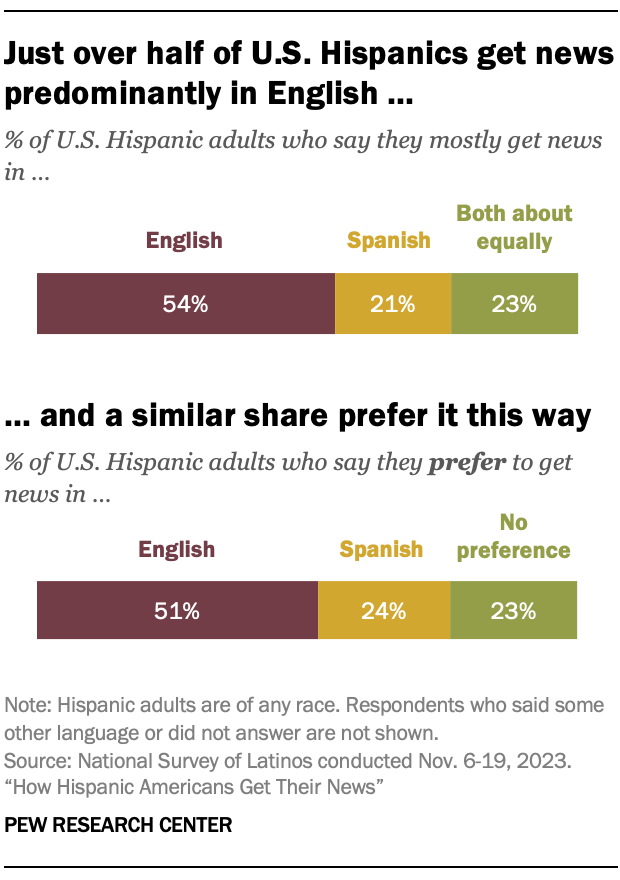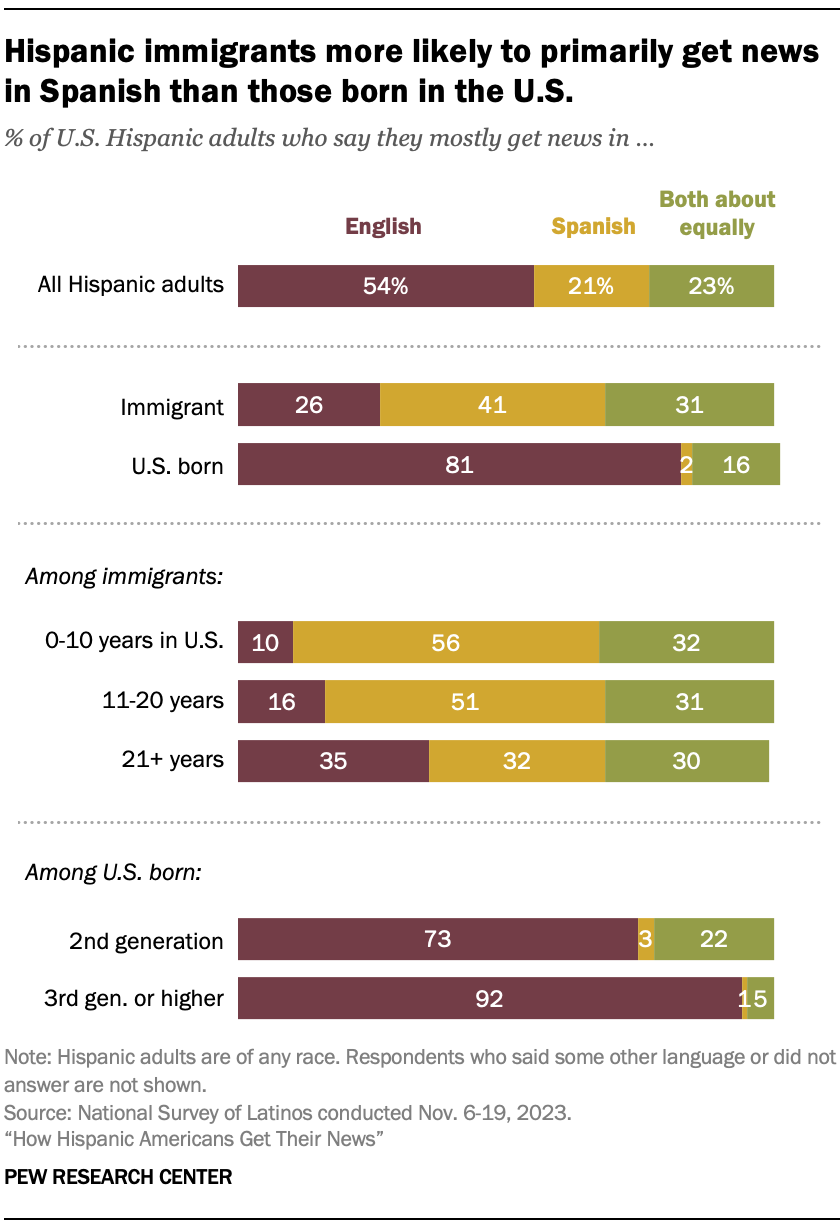
While two-thirds of U.S. Latinos say they can read a newspaper or book in Spanish at least pretty well, just 21% say they mostly consume news in Spanish.
Just over half of Hispanics (54%) report getting news mostly in English, while 23% say they consume news in both languages about equally. Only 1% say they mostly get news in a language that isn’t English or Spanish.
The survey also asked respondents what language they prefer for their news, regardless of their actual news consumption habits.
The results are similar: 51% say they prefer to get news in English, while 24% prefer Spanish and 23% say they don’t have a preference between the two. Fewer than 1% prefer to get news in a language other than Spanish or English.
Given the variety of language preferences and habits among U.S. Latinos, some news outlets offer multiple options for Spanish-speaking and Latino audiences. These include Spanish-language newscasts and translations of English-language news stories into Spanish. Some outlets like the Los Angeles Times provide not only Spanish-language news but also news specific to English-dominant Latinos.
Major differences between U.S.-born Latinos and immigrants

Latino immigrants are much more likely than U.S.-born Latinos to say they mainly consume news in Spanish. On the other hand, those born in the U.S. overwhelmingly turn to English-language news.
- Spanish-language news: 41% of Latino immigrants say they mostly get news in Spanish, compared with just 2% of U.S.-born Latinos.
- English-language news: 81% of U.S.-born Latinos say they mainly get news in English, while 26% of Latino immigrants say this.
- Both about equally: Latino immigrants are about twice as likely as those born in the U.S. to say they get news in both Spanish and English about equally (31% vs. 16%).
Latino immigrants who have spent more time in the U.S. are less likely than more recent arrivals to mostly consume news in Spanish, and they are more inclined to turn to English-language news instead.
Just over half of Latino adults who arrived in the U.S. in the past 10 years (56%) say they get news mostly in Spanish, while just 10% say they get news primarily in English. By contrast, among those who arrived more than 20 years ago, similar shares consume news mainly in Spanish (32%) and mainly in English (35%). About three-in-ten in both groups say they consume news in both languages equally.

Although a large majority of U.S.-born Hispanics consume news primarily in English, those whose parents were also born in the U.S. are especially likely to do this. While 73% of second-generation Hispanics (those with at least one immigrant parent) get news mainly in English, 92% of Hispanics who are third generation or higher (U.S.-born Hispanics with U.S.-born parents) say the same.
Second-generation Hispanics are more likely than those who are third generation or higher to get news about equally in both English and Spanish (22% vs. 5%). Very small shares of both groups get news mostly in Spanish (3% vs. 1%).
There are similar patterns across these groups on the question about which language Latinos prefer for news. It is worth noting, however, that Latino immigrants who came to the U.S. in the last 10 years are more likely to say they prefer news in Spanish than actually get news mostly in Spanish (68% vs. 56%).
Bilingual Hispanics much more likely to get news in English than Spanish

The primary language of news consumption among Latino Americans largely aligns with whether they are Spanish dominant, bilingual or English dominant (definitions for these terms are available in the Terminology section at the top of the overview). But about a third of Spanish-dominant U.S. Latinos report consuming at least as much news in English as in Spanish.
- Nine-in-ten English-dominant Hispanics consume news mostly in English, while 7% get news in English and Spanish about equally. Very few (1%) get mostly Spanish-language news.
- A smaller majority of Spanish-dominant Hispanics (64%) say they get news mainly in Spanish, while 29% consume about the same amount of news in English and Spanish and 5% get most of their news in English.
- Among bilingual Hispanics, 55% report getting news mostly in English, much higher than the share who say they primarily consume news in Spanish (9%). Roughly a third of bilingual Hispanics (34%) report consuming news in Spanish and English equally.


